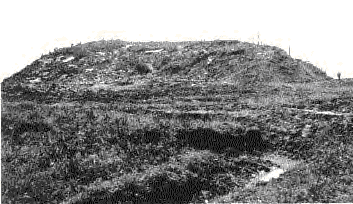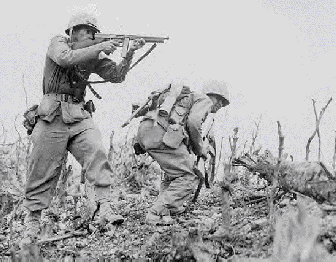Battle For Okinawa: World War II | home
Sugar-Loaf the Gateway to Naha
Photo Below; Sugar-loaf was one of the hardest fought regions of the Battle; Naha was home to the 32nd Japanese Army and Gateway to Naha and ultimately key to the southern end of the island. (Photo Courtesy of the 6th Marine Association)
 Killing Ground on Okinawa
Killing Ground on Okinawa "The Battle for Sugar Loaf Hill"
By James H. Hallas
Praeger Publishers. Westport, Conn. 1996. 272 pages
LC 95-22013. ISBN 0-275-94726-2. C4726 $47.95
On May 12, 1945, the 6th Marine Division was nearing Naha, capital of Okinawa. To the division's front lay a low, loaf-shaped hill. It looked no different from other hills seized with relative ease over the past few days. But this hill, soon to be dubbed, "Sugar Loaf," was very different indeed.
 Part of a complex of three hills, Sugar Loaf formed the western anchor of General Mitsuru Ushijima's Shuri Line, which stretched from coast to coast across the island. Sugar Loaf was critical to the defense of that line, preventing U.S. forces from turning the Japanese flank. Over the next week, the Marines made repeated attacks on the hill losing thousands of men to death, wounds, and combat fatigue. Not until May 18 was Sugar Loaf finally seized. Two days later, the Japanese mounted a battalion-sized counterattack in an effort to regain their lost position, but the Marines held.
Part of a complex of three hills, Sugar Loaf formed the western anchor of General Mitsuru Ushijima's Shuri Line, which stretched from coast to coast across the island. Sugar Loaf was critical to the defense of that line, preventing U.S. forces from turning the Japanese flank. Over the next week, the Marines made repeated attacks on the hill losing thousands of men to death, wounds, and combat fatigue. Not until May 18 was Sugar Loaf finally seized. Two days later, the Japanese mounted a battalion-sized counterattack in an effort to regain their lost position, but the Marines held.Photo; Left: Member of the 1st Marine Division draws a bead on
a Japanese Sniper while trying to take Wana Ridge
(National Archive Photo; Used with Permission)
 Frontal Assault ... Faulty Strategy?
Frontal Assault ... Faulty Strategy? Ironically, these losses may not have been necessary. General Lemuel Shepherd, Jr., had argued for an amphibious assault to the rear of the Japanese defense line, but his proposal was rejected by U.S. Tenth Army Commander General Simon Bolivar Buckner. That refusal led to a controversy that has continued to this day.
"Hallas's chronicle of the battle's many instances of grace under fire will enhance all collections devoted to war's human dimensions." - Publishers Weekly
Photo; Above: Naha. Capital of Okinawa Note the denuded vegetation from American bombardment during the softening up process
 Naha
Naha the Capital of Okinawa was nearly completely leveled.
Here the city sports a million souls in 1974. The Okin-awans suffered heavy loss-es in the Allied Bombard-ment; first suffering under the rule of the Japanese. My courier duty driver told me that times were rough during the war and that he and his family escaped the slave-labor forces organized by the Japanese. He said, that 'he and his family and many others found caves to hide in and had little food. But, were free. He hated the Japanese during the war; and after the war many Japanese escaped into the hills and hid out only armed with sharp sticks. He said he and his friends found weapons and often hunted for the soldiers.'